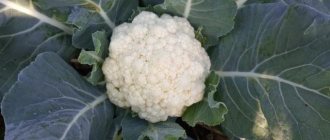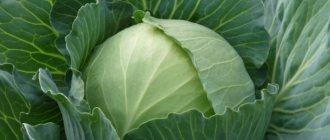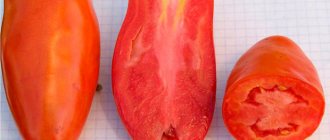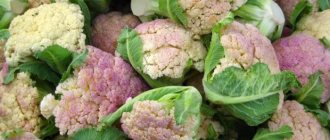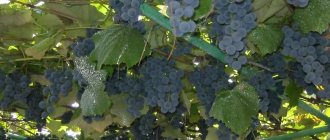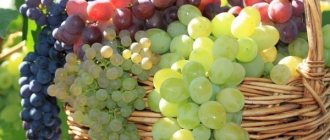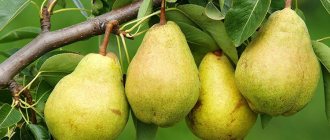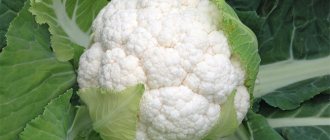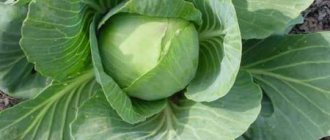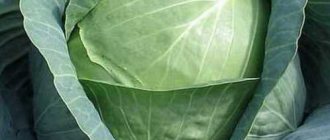Summer resident
Cauliflower, an early variety. The advantage of the vegetable is its long fruiting period. The ripening period occurs 80-100 days after the seedlings are transferred to the garden bed. The vegetable is characterized by a white round head with a slight flatness. The average weight of a vegetable is up to 1 kilogram.
The product contains a lot of ascorbic acid and sugar, which gives it an unusual taste. The leaves reliably protect the ripening head from the merciless rays of the sun, so the gardener receives clean fruits without defects. Summer cabbage usually produces small-sized fruits. When planting, it is important to adhere to the system: plant 3-5 seedlings per 1 square meter at a distance of 50 centimeters between the bushes.
Planting should be done in late May-early June. The vegetable tolerates transportation well and retains its beneficial properties for a long time if stored correctly.
Brief description of the culture, its features and application
Cauliflower belongs to a number of annual vegetables and is grown in open and closed soils. Its original name was “Syrian”, it was given because of the place where the first varieties were cultivated. It came to Europe in the 12th century and grew exclusively on royal lands; it was a delicacy and a great rarity.
In the Russian climate, foreign seeds did not take root well, but in the course of domestic selection, adapted varieties were bred. Despite the wide range of hybrids, cauliflower is rarely found in local gardens, giving way to its white sister.
Cauliflower is a plant with a fibrous root system, a thick cylindrical stem up to 70 cm high, on which lanceolate leaves with a clear waxy coating are located. In the upper leaves of the rosettes, a cabbage head is formed, consisting of individual, fleshy peduncles used for food. There are different colors:
- snow-white;
- cream;
- green;
- purple;
- yellow;
- orange.
The shade depends on the variety and the presence of coloring substances in the composition.
Interesting to know! In terms of taste and nutrient content, cauliflower is a leader among similar crops. The amount of vegetable protein and ascorbic acid is 2 times more than in cabbage!
The pulp contains vitamins B, PP, A, C; minerals – calcium, potassium, sodium, phosphorus, iron, zinc, manganese; sugar and fiber. The calorie content of 100 grams of cabbage is only 25-30 kcal, which puts it at the leading level among dietary products. It is used to prepare pureed soups, side dishes, main courses, casseroles, appetizers, stews, preserves and much more.
The vegetable is recommended to be consumed daily by children and adults, as well as by those who watch their figure and want to strengthen the immune system, treat the liver and gall bladder. There are contraindications for people suffering from gout and stomach ulcers.
Cooking cauliflower
Snowball
It’s not for nothing that cabbage got its name, characterized by a truly snow-white hue, while being small in size. The average weight of cabbage reaches 850 grams. Dense planting and compactness of the bushes ensures high yields, especially since there is no need for space for branching.
Early ripening cabbage is the best variety that has gained popularity among many gardeners. The advantage of the product is increased resistance to diseases. The rapid ripening period allows you to harvest several times in one season. From the moment the seedlings are planted until they fully mature, it takes about 2 months.
Movir
An early variety of cauliflower, famous for its increased resistance to cold and high temperatures. The peculiarity of this hybrid is its rapid ripening period. You can harvest 2 crops per season.
White cabbage has a round or rounded-flattened inflorescence. The shade is sometimes creamy. The weight of one head ranges from 500 grams to 1.2 kilograms. Cabbage has a low resistance to pests and diseases, but its taste is especially appreciated by gourmets. When seeds are planted, simultaneous germination occurs.
If you plant in mid-February and cover the transferred seedlings with film to protect them from possible spring frosts, you can harvest the fruits as early as June. It is imperative to plant seedlings at a distance of 50 centimeters from each other. The seedlings are transferred from late May to mid-June. It is recommended to feed the plant with nitrogen-potassium fertilizers.
Express
A variety of early maturing. Characterized by white inflorescences with a yellowish tint. Among the early ripening varieties, this species is considered the best in taste. The growing season is 62 days. When planting, maintain a distance of 25-35 centimeters between bushes and 60-70 centimeters between rows. This way the gardener will get a good harvest, considering that the average weight of the head is no more than 500 grams.
The vegetable does not have increased resistance to pests, but it is invulnerable to bacteriosis, a very dangerous disease. You can prevent pest infestations by regular weeding and preventive treatments.
You need to plan to transfer the seedlings to the garden bed in early May. It is recommended to cover the plants with film to protect them from possible night frosts.
Guarantee
The growing season of early ripening cabbage is 70-100 days. The average weight of one head is from 500 to 900 grams. This is a reliable domestic variety with a 50-year history. Cauliflower Guarantee is distinguished by its rapid ripening. Predominantly white or cream in color, the heads of cabbage have a rounded flat shape. The vegetable is very dense, its surface is granular and fine. The variety is recommended to be grown in open ground and under film.
Benefits of cabbage Guarantee:
- high productivity;
- excellent taste;
- low maintenance requirements.
The head of cabbage is semi-open, but at the same time it does not suffer from sunlight and practically does not need additional shading.
The best varieties of cauliflower
When choosing a cauliflower variety, experienced gardeners must pay attention to the ripening period, which can range from 50 to 200 days. Also important:
- ability to endure adverse conditions;
- productivity;
- taste and commercial qualities of inflorescences.
Early
Early varieties of cauliflower are ready for harvesting within 50–100 days after germination (late June - early July). And residents of the southern regions, when planting such varieties, can receive several harvests per season. But early ripening cauliflower also has its disadvantages. Its heads of cabbage are not as large as those of the late one, and are stored much less quickly.
Varieties with a short ripening period include:
- Moscow Ultra;
- Guarantee;
- Polar Star;
- Movir 74;
- Tsendis;
- Express MS;
- Dereza goat;
- Francoise;
- Yarik.
Guarantee
A domestic variety obtained by specialists from the Vegetable Experimental Station named after V.I. Edelshtein of the Timiryazev Agricultural Academy and entered into the State Register for all regions of Russia in 1968. Reaches removable maturity 70–98 days after germination.
Guarantee is characterized by round, cream or yellowish colored heads with a fine-grained surface. Their weight ranges from 500 g to 1.2 kg. The taste of the heads is excellent. The guarantee is not prone to discoloration, overgrowth and cracking. It also has relative resistance to such a dangerous disease as bacteriosis. The variety ripens quite smoothly. From 1.5 to 3.8 kg of cauliflower is harvested from 1 m2 of plantings.
The diameter of heads of cabbage variety Guarantee can reach 26 cm
Dereza goat
Goat dereza is one of the most famous varieties of Russian selection. Harvesting begins 50–70 days after germination. The vertical rosette consists of gray-green, slightly bubbly leaves that partially cover the inflorescences. The heads are round, dense, white. The taste is good. The average weight of heads of cabbage is 600–800 g, but under favorable conditions it can increase to 2.5 kg.
The yield of the variety is 3.2 kg/m2. It is characterized by uniform ripening, which allows you to collect most of the heads in one go. The variety easily tolerates short-term temperature drops to -5°C. Rarely affected by diseases characteristic of members of the cruciferous family.
The Koza-dereza cauliflower variety, bred by specialists, is recommended for cultivation in all regions of the Russian Federation
Video: personal experience of growing Koza-dereza cabbage
Francoise
Françoise ripens on the 90–100th day after germination. The heads are yellowish, rounded-flat, partially covered with gray-green leaves. They are not very dense, but have a very delicate texture. The weight of the heads of cabbage rarely exceeds 600 g. The average yield is about 3.2 kg/m2. The taste of the Françoise variety is assessed by experts as excellent. It is eaten fresh and subjected to all types of processing.
Mid-season
Mid-season varieties of cauliflower require 100 days and stable warm weather (above 20°C) to achieve harvestable maturity. Their main advantage is their long shelf life. Popular varieties of cauliflower with an average ripening period include:
- Summer resident;
- Purple ball;
- Purple;
- White head;
- Parisian;
- Clipper.
Summer resident
Dachnitsa is a variety that tolerates high humidity and sudden temperature changes and is recommended for cultivation in all regions of Russia. It is distinguished by an extended period of formation of inflorescences, thanks to which gardeners have the opportunity to harvest throughout the entire season. The variety forms a raised rosette of leaves with partially covered, flat-round, dense heads. Their color can vary from whitish to light cream. Average weight - 0.6–1 kg. The taste of the inflorescences received the highest ratings from experts. They are used for stewing, boiling and baking, fresh and after freezing.
purple ball
Lilac ball is an original variety that ripens 4 months after germination, which can be grown not only for food, but also for decorating the garden. It is distinguished by the deep purple color of its flat-round heads. They have a pleasant delicate texture and excellent taste.
Cauliflower variety Lilac ball will decorate any garden
Under favorable conditions, the weight of the Lilac Ball heads is about 900 g. The average yield of the variety is about 2.9 kg/m2. Its inflorescences are used as food after cooking. When preparing them, it is necessary to take into account that during cooking the color loses its brightness.
Video: the intricacies of growing cauliflower with unusual colors
Parisian
Parisianka is a variety resistant to diseases and low temperatures, reaching harvest maturity on the 110–120th day after germination. Forms dense round-flat heads of milky color, which are partially covered with light green leaves. Average weight - 750 g. Parisian has an excellent taste, which is preserved when frozen and canned. The average yield is 2.5 kg/m2.
Late
Late varieties of cauliflower ripen no earlier than 120 days after germination. Such a long waiting period is quite justified - large heads, which often weigh more than 1.5 kg, have excellent taste. In addition, they are well stored and transported over long distances.
Late-ripening varieties include:
- Agnia;
- Silver ball;
- Hispalis;
- Green snowdrift;
- Trident;
- Otis.
Agnia
A modern variety of Russian selection, created for sowing before winter. With this method of planting, the first harvest is harvested in mid-July. Typically it is about 2.5 kg/m2. The heads of Agnia are round-flat, whitish, with a fine-grained surface and delicate texture. They are well protected from the bright sun by blue-green leaves that completely cover the inflorescences. The average weight of heads of cabbage is 1.5 kg. The Agnia variety has good taste and excellent commercial qualities. It is used for boiling, stewing and baking.
Green snowdrift
Green Snowdrift is a Russian variety with rounded green heads, partially covered with greyish, long elliptical leaves. It ripens on the 180–190th day after germination. The average weight of Green Snowdrift heads is 740–840 g. The taste and commercial qualities of the variety are very high. It is used for fresh consumption and all types of processing. The Green Snowdrift variety is immune to bacteriosis.
One square meter of Green Snowdrift plantings yields about 2.1 kg of high-quality heads with original coloring
Dutch varieties
Recently, hybrids bred by Dutch breeders have become especially popular. They are distinguished by stable productivity, unpretentiousness, and even heads.
Table: hybrids of Dutch selection common in Russia and the CIS countries
| Hybrid name | Maturation period | Productivity (kg/m2) | Average head weight (kg) | Short description |
| Amerigo | Mid-late | 3,1–4,5 | 1,5 | The heads are round, medium-lumpy, dense, completely covered with gray-green leaves. The color is whitish, the texture is delicate. The taste is excellent. The hybrid is able to tolerate low temperatures at the end of the growing season and rarely suffers from disease. Among its disadvantages, one can only note its demands on soil fertility. |
| Goodman | Mid-early | 3,2–4,6 | 0,6–0,7 | Partially covered with blue-green wavy leaves, the heads are round-flat, whitish-yellow, with medium to coarse tuberosity, uniform in size. The taste is excellent. Recommended for canning and preparing summer salads. Goodman is rarely affected by disease, but does not tolerate drought well. |
| Vinson | Early | 5,9 | 1,8 | The whitish, round-flat, partially covered heads have a dense structure and excellent taste. |
| Cortez | Early | 2,0–3,9 | 0,6–2,0 | White, medium-lumpy, round, dense heads are partially covered with green leaves. The taste is good. The hybrid is characterized by stable yield and high marketability. |
| Malimba | Early | about 4 | 0,6–1,5 | The heads are flat-round, dense, milky white, covered with leaves. Used for stewing, boiling and baking fresh and canning. The taste is excellent. Malimba is resistant to common infections, but suffers greatly from lack of moisture and nutrients. It reacts especially poorly to excessive acidification of the soil, which can lead to a significant decrease in yield, and sometimes to the death of the plant. |
| Santamaria | Medium (75–95 days) | 3,6 | 0,8–1,5 | The heads are elliptical, dense, completely covered with leaves. White color. The hybrid is suitable for all-season cultivation in closed ground. It easily tolerates drought and potassium deficiency, and is rarely affected by fungal infections. Santamaria cauliflower keeps well fresh and does not lose its taste after freezing. |
| Fortaleza | Mid-season | 4,9 | 2.8 | Tuberous, rounded-flat, partially covered with gray-green vesicular leaves, the heads are whitish in color and have a delicate structure. The taste is excellent. |
| Fremont | Mid-early | 4,6–5,5 | 1.5–2 | The heads are flat-round, dense, white, very tuberous, completely closed. The structure is delicate. The taste is excellent. Fremont forms uniformly sized heads and easily tolerates heat. |
Photo gallery: Dutch cauliflower hybrids
Amerigo's heads are securely closed from the scorching sun
Hybrid Vinson can be grown both in open ground and in greenhouses
Goodman requires regular watering to set and grow heads.
The heads of the hybrid Cortez are distinguished by high commercial qualities. No more than 55 days pass from the emergence of Malimba shoots to the ripening of the heads.
Santamaria heads are ready for harvesting 75–95 days after planting the seedlings in a permanent place
Due to the almost complete covering of Fortaleza heads with leaves, they do not suffer from sunlight
Under favorable conditions, the weight of Fremont heads often reaches 5 kg
Highly productive
Typically, from 1 m2 occupied by cauliflower, 2 to 4 kg of marketable products are collected. But recently, hybrids have been developed whose yield reaches 8–10 kg/m2. For example:
- Prudentia. Mid-early Dutch hybrid, zoned on the territory of the Russian Federation in 2021. Forms round-flat, almost white heads weighing about 2.3 kg. The taste is excellent. 1 m2 of beds of this hybrid yields up to 11.5 kg of vegetables, used for cooking, stewing and canning.
- Octopus. A mid-late hybrid with wide-elliptical whitish tuberous heads, completely covered with gray-green leaves. The taste is excellent. The productivity of Octopus ranges from 6 to 9.5 kg/m2.
- Flirting. French mid-season hybrid with rounded whitish heads weighing 1.5–2.2 kg, partially covered with gray-green leaves. Productivity - from 6.2 to 9.1 kg/m2. Flirt inflorescences are very tasty. They are used for fresh consumption after heat treatment.
- Ferraro. Dutch mid-season hybrid, recommended by the State Commission for cultivation in all regions of our country. Its heads, slightly covered with gray-green leaves, have a broadly elliptical shape and are almost white in color. At the stage of removable maturity, their weight is 2–2.3 kg. 1 m2 of Ferraro beds yields about 8 kg of inflorescences with excellent taste.
Domestic
An early variety of cauliflower that does not care about day length. Cabbage can be planted both in open ground and under film. The growing season is 110-130 days. The average weight of one head does not exceed 1 kilogram. Cabbage has dense, white heads of cabbage that have a rounded-flat shape.
Cabbage has a delicate taste. This variety can be transported without problems. Domestic cauliflower is used for consumption in fresh, boiled, stewed, baked form. It is also allowed to be used for canning.
Varieties and hybrids for regions
When choosing a cauliflower variety for planting, the climate of the region is of great importance. Thus, varieties that bring a bountiful harvest in the south grow poorly and set their heads in cool weather, characteristic of more northern regions, and vice versa.
For central Russia and the Moscow region
The short and not too warm summer of the Moscow region and the entire central zone allows the cultivation of only varieties of cauliflower with a short growing season. The following representatives of this culture show good results here:
- Moscow Ultra;
- Movir 74;
- Vinson;
- Polar Star;
- Goodman;
- Summer resident;
- Dereza goat.
For the Urals and Siberia
Cauliflower varieties grown in Siberia and the Urals must not only have time to ripen in a short summer, but also be resistant to sudden weather changes and short-term frosts. The following cope with such extreme conditions better than others:
- Parisian;
- Dereza goat;
- Movir 74;
- Express MS;
- Snowball;
- Santamaria.
For the Black Earth Region
Thanks to the warm and long summer, residents of the Black Earth Region can grow varieties of cauliflower with any ripening period. The main thing is that they can easily tolerate elevated temperatures and lack of moisture. These requirements are met:
- Fremont;
- Santamaria;
- Fortaleza;
- Green snowdrift;
- Goodman;
- Vinson.
Alpha
An early-ripening variety of cauliflower, characterized by high yield and excellent taste. The advantage of this variety is that it contains a large amount of sugars. The heads are large, the average weight of the vegetable reaches 0.5-2 kilograms. The growing season lasts for 70-85 days.
Alpha cabbage has white dense heads of cabbage, round-flat in shape. Cabbage is consumed fresh and used for pickling and freezing. Cauliflower ripens in early spring and can be harvested until late autumn.
Goodman
Like many modern Dutch hybrids, this variety attracts with its high yield over a short growing season - 65-80 days. But this is only provided that the gardener regularly waters and feeds the plant, not forgetting about cultivating the soil.
The average weight of the head is 1.2-1.5 kilograms. Cabbage is snow-white with elastic and dense forks that can be frozen, and after defrosting the vegetable does not lose its color and taste. Goodman has a strong root system and can withstand temperature changes and adverse weather. This variety is resistant even to extreme heat.
The heads are round, the inflorescences are dense and hard, completely covered with leaves. Farmers greatly value this variety of crop because it is resistant to fungal diseases. The heads are resistant to yellowing. The vegetable easily withstands transportation, while being distinguished by the high quality of the heads and their excellent external neatness.
Kohlrabi
The name of this variety of cabbage consists of two German words: koil - cabbage and ribe - turnip. Its stem fruit actually somewhat resembles a turnip. The plant itself is compact, consisting of a root, a thickened stem and a small number of elongated and upward-pointing leaves. The State Register of Breeding Achievements recommends about 30 varieties of vegetables for cultivation in the Russian Federation. They differ in ripening time (from early to late ripening), fruit weight (from 0.3 to 3 kg), peel color (from white to dark purple).
Among kohlrabi there are varieties with green, yellow, snow-white and purple colors.
Kohlrabi, like other varieties of cabbage, is grown by sowing seeds in the ground or through seedlings. It does not impose any special maintenance requirements, with the exception of soil breathability. Only in loose soil do tender and juicy stem fruits ripen, but if they are not removed in time, the pulp can harden and become fibrous.
Kohlrabi will grow in soils of any composition, except acidic and depleted ones, in which the stem fruits grow coarsely fibrous and hard
The taste of the vegetable resembles the stalk of white cabbage, but without the bitterness. The stem fruit contains a number of vitamins, a lot of potassium and calcium, fructose and glucose. This variety of cabbage is recommended for diabetics. It is universal in use. Delicious puree soups are prepared from kohlrabi; the fruit can be stuffed, pickled, and added to salads. The stem fruit is perfectly stored in a dry and cool room.
Video: the best way to eat kohlrabi
Dereza goat
This is a medium ripe variety. It is distinguished by its compactness and white head, with a predominant yellowish and sometimes reddish tint. The upright plant bears fruits whose average weight is 800 grams, and with proper care can exceed 2 kilograms.
The growing season of the plant is 53-70 days. The seedlings germinate well and develop well. Shoots can be planted from the second half of April to mid-July. When planting, there are 4 plants per 1 square meter. This cabbage variety is very demanding on soil composition. When planting, it is important not to forget about fertilizers and fertilizing.
Cortez F1
Among the varieties of late cabbage, this hybrid is considered one of the most productive. The plant is distinguished by a beautiful and dense white head, very massive and juicy. This cabbage is often grown for subsequent fresh sale, although it tolerates long-term transportation and storage. Since Cortes F1 is a late hybrid, the heads can ripen even during the first autumn frosts, which they are not at all afraid of. However, this cabbage is very demanding on the composition and quality of the soil, and also requires regular feeding and fertilizing.
| Purpose | Productivity (kg per 1 sq.m.) | Head weight (g) | Ripening (days from the moment of planting of seedlings) | Peculiarities |
| 5-7 | 2000-3000 | 75 | The ability of a plant to self-shelter leaves from heat | |
flora blanca
A mid-season variety of cauliflower, dominated by rounded-flattened white inflorescences with a creamy tint. The growing season is 109-112 days. The average weight of one head is 1.2 kilograms.
The fruits are tightly covered with leaves, so the heads are reliably protected from the scorching rays of the sun, which can cause black spots and a bitter taste. Germination and ripening are consistent, which means harvesting will be almost simultaneous.
A distance of 50 centimeters and 70 centimeters is maintained between bushes and row spacing. Cabbage is highly resistant to bacteriosis and cold, and does not lose its taste for a long time if stored correctly.
Sicily
Another variety of cauliflower comes from Italy. Its name is associated with the island of the same name, where the variety presumably originates. Sicily has a bright purple color, so it is famous not only for its taste, but also for its spectacular appearance.
Characteristics:
| Originator and year of inclusion in the register | The plant is not included in the State Register |
| Recommended growing region | Subtropics and southern part of the temperate climate zone |
| The growing season from the appearance of the first shoots to full ripeness | 80-85 days |
| Head color | Light purple |
| Weight | 1.5-2 kg |
| Productivity | 3-5 kg/1 m2 |
| Advantages | The fruit has many beneficial substances and helps cleanse the body of carcinogens. |
The heads grow flat-round, compact, approximately 15 cm in diameter. They are surrounded by thick foliage that does not cover them. But this is not necessary. The more sunlight Sicily receives, the more saturated its color becomes.
Related article:
Growing Brussels sprouts from seedlings
In agrotechnical terms, the crop does not require the use of any special techniques. It is even easier to grow because it has strong immunity and is resistant to adverse environmental conditions. Its application is universal. The vegetable can be used for preparing dietary dishes, as well as for freezing.
Interestingly, when boiled, the inflorescences of Sicily become bright green.
White beauty
Round inflorescences attract gardeners. Mid-season cauliflower is a high-yielding species. Due to the large head, the weight of cabbage varies from 0.8 to 1.2 kilograms. The growing season lasts 55-65 days after planting seedlings in an open garden bed.
A peculiarity of the crop is its inability to cope with temperature changes and pests, so it is necessary not only to cover the transferred seedlings with a thick film, but also to regularly carry out preventive treatments against parasites. Cabbage retains its dense structure and transport properties well. Even freezing will not spoil the appearance of White Beauty cabbage.
Features of cultivation
Cauliflower is distinguished not only by its unusual appearance. It also has a special taste, for which many people love this vegetable. Before growing the selected variety, you need to know the basic care features.
As for the pros and cons of cauliflower, it is worth saying that gardeners who already have experience growing this crop unanimously claim that a short storage period can be considered a “conditional” disadvantage.
The best varieties of broccoli!
The best varieties of broccoli for Siberia, the Urals, the Moscow region and the middle zone.
The following care features are noted:
- Moderate, systematic watering. After the cabbage seedlings are transplanted to a permanent place of growth, the soil is moistened 3 times every 7 days. Gradually, as the bush develops, it is reduced to 2.
- Oddly enough, the culture does not like the loosening procedure. Its roots are located very close to the surface of the earth and there is a risk of damage. In addition, all the necessary substances and moisture reach them without additional effort. Mulching or moderate hilling is preferable. The material used is sawdust, peat or humus.
- During the growing season, cauliflower is fertilized 3 to 4 times. The very first one is carried out 14 days after planting the seedlings. They bring in mullein. Next one, after about 12 days. Organics can be diluted with minerals.
- It is important to strictly follow all the rules of agricultural technology so that cabbage has good immunity. Otherwise, diseases and pest damage are possible.
Important!
Growing cauliflower will require significantly more effort than growing cabbage.
GROWING CAULIFLOWER FROM SEED TO HARVEST - video
Amerigo
The Amerigo variety is a late-ripening vegetable. The growing season lasts 74-80 days. The snow-white heads of cabbage are round and massive. The weight of one copy can be 2-2.5 kilograms. Unlike other varieties, this variety is characterized by increased resistance to pests and viral diseases. The advantage of Amerigo is its increased resistance to cold; cabbage does not deteriorate not only in appearance, but also in taste.
Due to its intensive growth, cauliflower needs regular feeding. Large leaves reliably protect the heads from the scorching rays of the sun, creating shading. From the second half of May to the beginning of June, seedlings can be planted. The distance between bushes and rows should be 70-80 centimeters.
When planting cauliflower, you need to pay a lot of attention to the vegetable. Only in this case, the gardener can expect high yields, healthy fruits and no defects on the heads. It is imperative to follow the conditions for caring for the plant: water, fertilize, treat against diseases and pests.
0
0
Copy link
Regent
Plants of this variety are recommended to be planted in summer cottages in temperate climate zones. The variety is a mid-early variety, and the onset of fruiting is directly related to climatic conditions and ambient temperature. The cabbage head is round, small, with large tubercles, usually covered with medium-sized leaves. Color – white-yellow. The taste is very good, which makes it possible to use cabbage for preparing various dishes. Plants are practically not affected by bacteriosis.
| Purpose | Productivity (kg per 1 sq.m.) | Head weight (g) | Ripening (days from the moment of planting of seedlings) | Peculiarities |
| 2-2,5 | 500-600 | 55-65 | Ascorbic acid content – 50.9 mg per 100 g of raw material | |
